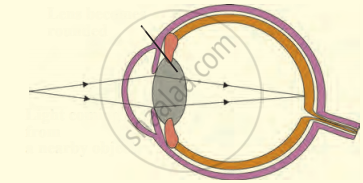Advertisements
Advertisements
प्रश्न
Given below is certain structure. Write against them its functional acivity.
retina and ……………………….
उत्तर
Retina and vision
APPEARS IN
संबंधित प्रश्न
Explain the following:
Mechanism of generation of light-induced impulse in the retina.
Where is the image formed in a human eye?
Name that part of the eye which is equivalent to the photographic film in a camera.
What are rods and cones in the retina of an eye? Why is our night vision relatively poor compared to the night vision of an owl?
Among animals, the predators (like lions) have their eyes facing forward at the front of their heads, whereas the animals of prey (like rabbit) usually have eyes at the sides of their head. Why is this so?
Note the relationship between the first two words and suggest the suitable word/words for the fourth place.
Cones : Iodopsim :: Rods : ______.
What is a lacrimal gland?
In what two ways is the yellow spot different from the blind spot?
What is the function of iris and the muscles connected to the lens in human eye?
Name the following:
The focal length of the lens is altered by the contraction of which type of muscles.
Name the following:
The area where the image is formed but not seen by our eye is termed as.
Write the name.
The fleshy screen behind cornea.
The following figure show the change in the shape of the lens while seeing distant and nearby objects. Complete the figures by correctly labelling the diagram.

The black opening between the aqueous humour and the lens is called ____________.
______ of the eye is comparable to the film of a camera.
What is ‘white of the eye’?
Match the following:
| Column - I | Column - II |
| 1. Retina | a) Path way of light |
| 2. Pupil | b) Far point comes closer |
| 3. Ciliary muscles | c) near point moves away |
| 4. Myopia | d) Screen of the eye |
| 5. Hypermetropia | e) Power of accommodation |
Vitreous humour is present between ______.
Match the following:
|
Column - I |
Column - II | ||
| 1 | Retina | a | Path way of light |
| 2 | Pupil | b |
far point comes closer |
| 3 | Ciliary muscles | c |
near point moves away |
| 4 | Myopia | d | Screen of the eye |
| 5 | Hypermetropia | e | Power of accommodation |
Name the following:
Two pigments of the sensory cells.
